 |
Thesaurus Indogermanischer Text- und Sprachmaterialien |
|
| TITUS | DIDACTICA |
1. The phonemic inventory (traditional interpretation)
1.1. Non-sonorants (obstruents and laryngeals):
| Stops | Tenues (voiceless-nonaspirated) |
Tenues aspiratae (voiceless-aspirated) |
Mediae (voiced-nonaspirated) |
Mediae aspiratae (voiced-aspirated) |
| Labials | p | ph | b | bh |
| Dentals | t | th | d | dh |
| Palatals | ḱ | ḱh | ǵ | ǵh |
| Velars | k | kh | g | gh |
| Labiovelars | kw | kwh | gw | gwh |
| Sibilants | voiceless | voiceless-aspirated | voiced | |
| Dental | s | / | / | |
| Laryngeals | h1 | h2 | h3 |
1.2. Sonorants (vowels, nasals and liquids):
| Nasals and Liquids | r | l | m | n |
| Vowels | front | central | back | |||
| short | long | short | long | short | long | |
| High | i | u | ||||
| Non-high | e | ē | a | ā | o | ō |
1.3. The ablaut system:
| Primary (e-) grades | Secondary (o-) grades | (a-) grades | |
| Long grades | ē | ō | (ā) |
| Normal (full) grades | e | o | (a) |
| Zero (reduced) grade | Ø | ||
1.4. PIE phonemes arranged by distinctive features
| p | ph | b | bh | t | th | d | dh | ḱ | ḱh | ǵ | ǵh | k | kh | g | gh | kw | kwh | gw | gwh | s | h1 | h2 | h3 | |
| consonant | + | + | + | + | + | + | + | + | + | + | + | + | + | + | + | + | + | + | + | + | + | + | + | + |
| obstruent | + | + | + | + | + | + | + | + | + | + | + | + | + | + | + | + | + | + | + | + | + | + | + | + |
| syllabic | – | – | – | – | – | – | – | – | – | – | – | – | – | – | – | – | – | – | – | – | – | – | – | – |
| nasal | – | – | – | – | – | – | – | – | – | – | – | – | – | – | – | – | – | – | – | – | – | – | – | – |
| low | – | – | – | – | – | – | – | – | – | – | – | – | – | – | – | – | – | – | – | – | – | + | + | + |
| high | – | – | – | – | – | – | – | – | + | + | + | + | + | + | + | + | + | + | + | + | – | – | – | – |
| back | – | – | – | – | – | – | – | – | – | – | – | – | + | + | + | + | + | + | + | + | – | – | + | + |
| round | – | – | – | – | – | – | – | – | – | – | – | – | – | – | – | – | + | + | + | + | – | – | – | + |
| anterior | + | + | + | + | + | + | + | + | + | + | + | + | – | – | – | – | – | – | – | – | + | – | – | – |
| coronal | – | – | – | – | + | + | + | + | – | – | – | – | – | – | – | – | – | – | – | – | + | – | – | – |
| lateral | – | – | – | – | – | – | – | – | – | – | – | – | – | – | – | – | – | – | – | – | – | – | – | – |
| continuant | – | – | – | – | – | – | – | – | – | – | – | – | – | – | – | – | – | – | – | – | + | – | + | – |
| fricative | – | – | – | – | – | – | – | – | – | – | – | – | – | – | – | – | – | – | – | – | + | – | + | – |
| aspirated | – | + | – | + | – | + | – | + | – | + | – | + | – | + | – | + | – | + | – | + | – | – | + | – |
| voiced | – | – | + | + | – | – | + | + | – | – | + | + | – | – | + | + | – | – | + | + | – | – | – | + |
| tense | – | – | – | – | – | – | – | – | – | – | – | – | – | – | – | – | – | – | – | – | – | – | – | – |
| r | l | m | n | i | u | e | ē | o | ō | a | ā | |
| consonant | + | + | + | + | – | – | – | – | – | – | – | – |
| obstruent | – | – | – | – | – | – | – | – | – | – | – | – |
| syllabic | – | – | – | – | – | – | + | + | + | + | + | + |
| nasal | – | – | + | + | – | – | – | – | – | – | – | – |
| low | – | – | – | – | – | – | – | – | – | – | – | – |
| high | – | – | – | – | + | + | – | – | – | – | – | – |
| back | – | – | – | – | – | + | – | – | + | + | + | + |
| round | – | – | + | – | – | + | – | – | + | + | – | – |
| anterior | + | + | + | + | – | – | – | – | – | – | – | – |
| coronal | + | + | – | + | – | – | – | – | – | – | – | – |
| lateral | – | + | – | – | – | – | – | – | – | – | – | – |
| continuant | + | + | – | – | + | + | + | + | + | + | + | + |
| fricative | + | + | – | – | – | – | – | – | – | – | – | – |
| aspirated | – | – | – | – | – | – | – | – | – | – | – | – |
| voiced | + | + | + | + | + | + | + | + | + | + | + | + |
| tense | – | – | – | – | – | – | – | + | – | + | – | + |
1.5. PIE phonemes grouped under cover symbols:
| p | ph | b | bh | t | th | d | dh | ḱ | ḱh | ǵ | ǵh | k | kh | g | gh | kw | kwh | gw | gwh | s | h1 | h2 | h3 | |
| C | + | + | + | + | + | + | + | + | + | + | + | + | + | + | + | + | + | + | + | + | + | + | + | + |
| Z | + | + | + | + | + | + | + | + | + | + | + | + | + | + | + | + | + | + | + | + | – | + | – | + |
| P | + | – | – | – | + | – | – | – | + | – | – | – | + | – | – | – | + | – | – | – | – | + | – | – |
| Ph | – | + | – | – | – | + | – | – | – | + | – | – | – | + | – | – | – | + | – | – | – | – | – | – |
| B | – | – | + | – | – | – | + | – | – | – | + | – | – | – | + | – | – | – | + | – | – | – | – | + |
| Bh | – | – | – | + | – | – | – | + | – | – | – | + | – | – | – | + | – | – | – | + | – | – | – | – |
| Ψ | + | + | – | – | + | + | – | – | + | + | – | – | + | + | – | – | + | + | – | – | + | + | + | |
| Γ | – | – | + | + | – | – | + | + | – | – | + | + | – | – | + | + | – | – | + | + | – | – | – | + |
| Δ | + | – | + | – | + | – | + | – | + | – | + | – | + | – | + | – | + | – | + | – | + | + | – | – |
| Φ | – | + | – | + | – | + | – | + | – | + | – | + | – | + | – | + | – | + | – | + | – | – | + | – |
| S | – | – | – | – | – | – | – | – | – | – | – | – | – | – | – | – | – | – | – | – | + | – | + | – |
| H | – | – | – | – | – | – | – | – | – | – | – | – | – | – | – | – | – | – | – | – | – | + | + | + |
| Π | + | + | + | + | – | – | – | – | – | – | – | – | – | – | – | – | – | – | – | – | – | – | – | – |
| T | – | – | – | – | + | + | + | + | – | – | – | – | – | – | – | – | – | – | – | – | + | – | – | – |
| Ξ | – | – | – | – | – | – | – | – | + | + | + | + | + | + | + | + | + | + | + | + | – | – | – | – |
| Ḱ | – | – | – | – | – | – | – | – | + | + | + | + | – | – | – | – | – | – | – | – | – | – | – | – |
| X | – | – | – | – | – | – | – | – | – | – | – | – | + | + | + | + | – | – | – | – | – | – | – | – |
| Q | – | – | – | – | – | – | – | – | – | – | – | – | – | – | – | – | + | + | + | + | – | – | – | – |
| K | – | – | – | – | – | – | – | – | + | – | – | – | + | – | – | – | + | – | – | – | – | – | – | – |
| Kh | – | – | – | – | – | – | – | – | – | + | – | – | – | + | – | – | – | + | – | – | – | – | – | – |
| G | – | – | – | – | – | – | – | – | – | – | + | – | – | – | + | – | – | – | + | – | – | – | – | – |
| Gh | – | – | – | – | – | – | – | – | – | – | – | + | – | – | – | + | – | – | – | + | – | – | – | – |
| r | l | m | n | i | u | e | ē | o | ō | a | ā | |
| C | + | + | + | + | – | – | – | – | – | – | – | – |
| V | + | + | + | + | + | + | + | + | + | + | + | + |
| U | – | – | – | – | + | + | + | + | + | + | + | + |
| Ω | – | – | – | – | – | – | + | + | + | + | + | + |
| E | – | – | – | – | – | – | + | + | – | – | – | – |
| O | – | – | – | – | – | – | – | – | + | + | – | – |
| A | – | – | – | – | – | – | – | – | – | – | + | + |
| F | – | – | – | – | + | + | + | – | + | – | + | – |
| W | – | – | – | – | – | – | – | + | – | + | – | + |
| M | – | – | + | – | – | + | – | – | – | – | – | – |
| R | + | + | + | + | + | + | – | – | – | – | – | – |
| L | + | + | – | – | – | – | – | – | – | – | – | – |
| N | – | – | + | + | – | – | – | – | – | – | – | – |
| I | – | – | – | – | + | + | – | – | – | – | – | – |
| J | – | – | – | – | + | – | + | + | – | – | – | – |
| Y | – | – | – | – | – | + | – | – | + | + | – | – |
2. Phonemes and their phonetic realization (overview)
2.1. Non-sonorants (obstruents and laryngeals)
| Stops (voiceless-nonaspirated) |
Tenues (voiceless-aspirated) |
Tenues aspiratae | Mediae (voiced-nonaspirated) |
Mediae aspiratae (voiced-aspirated ) |
| Labials | p | ph | b | bh |
| [p, b1] | [ph, p2] | [b, p3] | [bh, p2] | |
| Dentals | t | th | d | dh |
| [t, d1, dh4, th5] | [th, t2] | [d, dh5, t3] | [dh, t2] | |
| [ts6, dz6+1,3] | [tsh6, ts6+2] | [dz6, ts6+3] | [dzh6, ts6+2] | |
| [tś7, dź7+1,3] | [tśh7, tś7+2] | [dź7, tś7+3] | [dźh7, tś7+2] | |
| Palatals | ḱ | ḱh | ǵ | ǵh |
| [ḱ, ǵ1, ǵh4, ḱh5] | [ḱh, ḱ2] | [ǵ, ǵh5, ḱ3] | [ǵh, ǵ2] | |
| Velars | k | kh | g | gh |
| [k, g1, gh4, kh5] | [kh, k2] | [g, gh5, k3] | [gh, g2] | |
| Labiovelars | kw | kwh | gw | gwh |
| [kw, gw1, gwh4, kwh5] | [kwh, kw2] | [gw, gwh5, kw3] | [gwh, gw2] | |
| Sibilants | voiceless | voiceless aspirated | voiced | voiced aspirated |
| Dental | s | |||
| [s, z1, sh5, zh4] | ||||
| [š8, ž7+1, žh7+4] | ||||
| Laryngeals | h1 | h2 | h3 | |
| [˒; ˒əe9, əe˒9] | [h; həa9, əah9] | [˓; ˓əo9, əo˓9] | ||
| [Ø10] | ||||
2.2. Sonorants (vowels, nasals and liquids):
| Nasals and Liquids | r | l | m | n |
| [r; r̥1, r̥̄1+2] | [l; l̥1, l̥̄1+3] | [m; m̥1, m̥̄1+4] | [n; n̥1, n̥̄1+5] |
| Vowels | front | central | back | |||
| short | long | short | long | short | long | |
| High | i | u | ||||
| [i; ī12] | [u; ū12] | |||||
| [i̯13] | [u̯13] | |||||
| Non-high | e | ē | a | ā | o | ō |
| [e, a6, o7] | [ē8] | [a] | [ā] | [o] | [ō] | |
| [ē9, ā10, ō11] | [ā12] | [ō12] | ||||
3. Sample: Obstruent p
| PIE | Attested I.E. languages | ||||||||||||||
| phonolog. input | phonetic output | condition / meaning | Ved. | Avest. | Greek | Arm. | Latin | OIr. | Goth. | OHG | OCS | Lith. | Hitt. | Toch.A | Toch.B |
| p | p | #_V | p | p | π | h | p | f | f | p | p | p | p | p | |
| pˈotis | pótis | ‘lord, master, husband’ (nom.sg.m.) | pátiḥ | paitiš | πόσις | potis | -faþs | (-pod-) | -pats | pats | petso | ||||
| ph2tˈēr | pəa(h)tḗr | ‘father’ (nom.sg.m.) | πατήρ | hayr | pater | athir | (fadar) | fater | pācar | pācer | |||||
| pəa(h)tḗ | pitā́ | (p(i))tā | |||||||||||||
| pˈōds | pο̄́ts | ‘foot’ (nom./acc.sg.) | pā́t | πούς | (pēs) | (fotus) | fuoz | ||||||||
| pˈodm | pódm̥ | pā́dam | pādəm | πόδα | otn | (pedem) | fotu | fuoz | patan | (pe) | (pai) | ||||
| pˈelh1u- | pél՚u- | ‘much’ (masc./ntr. stem) | il | filu | filu | ||||||||||
| plh1ˈu- | pl̥՚ú- | purú- | pouru- | (πολύ-) | |||||||||||
| pˈeḱus | péḱus | ‘livestock’ (nom.sg.f.) | páśuḥ | pasuš | (pecus) | faihu | fihu | pekùs | |||||||
| pˈontēh2s | póntē(h)s | ‘way, path’ (nom./gen.sg.) | pánthāḥ | pantå̄ | (πόντος) | hown | (pons) | pǫtĭ | |||||||
| pnth2ˈes | pn̥thh2as | patháḥ | paϑō | ||||||||||||
| p | p | #_V*Q | p | p | π | c | c | f | f | p | p | p | p | p | |
| pˈenkwe | pénkwe | ‘five’ (indecl.) | páñca | panca | πέντε | hing | quīnque | cóic | fimf | fimf | (pętĭ) | (penkì) | päñ | piś | |
| pˈekweti | pékweti | ‘cooks’ (3.sg.prs.) | pácati | pacaiti | coquit | pečetŭ | (kẽpa) | (pakät) | (pakṣäṃ) | ||||||
| -pˈokwos | -pókwos | ‘-cook’ (nom.sg.m.) | -κόπος | ||||||||||||
| p | p | #s_V*Ξ | p | p | Κ*π | p | u̯ | p | p | p | p | p | p | p | |
| (s)pˈeḱieti | (s)péḱi̯eti | ‘looks’ (3.sg.prs.) | páśyati | spasiieiti | σκέπτε(ται) | specit | (spehōt) | ||||||||
| p | p | #_C | p | f | π | p | f | f | p | p | p | p | p | ||
| prˈo | pró | ‘for(-)’ (prep./prev.) | prá | frā | πρό | pro- | ro- | fra- | fir- | pro- | pra- | ||||
| plˈeueti | pléu̯eti | ‘floats’ (3.sg.prs.) | (plávate) | (frauua-) | πλέει | (plovet) | (flew-) | plovetŭ | |||||||
| p | p | V́_V | p | p | π | v,w | p | f | f | p | p | p | p | p | |
| ˈuperos | úperos | ‘upper’ (nom.sg.m.) | úparaḥ | uparō | ὕπερος | (superus) | (ufaro) | ||||||||
| nˈepōts | népōts | ‘nephew’ (nom./acc.sg.) | nápāt | napå̄ | nepōs | nia | neuo | (nepuotis) | |||||||
| nˈepotm | népotm̥ | nápātam | napātəm | (νέποδ-) | (nepōtem) | (nepuotį) | |||||||||
| p | p | V_V́ | p | p | π | v,w | p | b | b | p | p | p | p | p | |
| upˈeri | upéri | ‘over’ (adv.) | upári | upairi | (ὑπέρ) | ver | (super) | (for-) | ubir | ||||||
| h1ˈepi | ՚épi | ‘above, on’ (adv.) | ápi | aipi | ἔπι | ew | |||||||||
| p | p | V_PV́ | p | p | π | v,w | p | b | b | p | p | p | p | p | |
| septˈm | septḿ̥ | ‘seven’ (indecl.) | saptá | hapta | ἑπτά | ewtՙn | septem | (secht) | (sibun) | (sibun) | sedmĭ | (septynì) | ṣpät | ṣukt | |
| p | p | V_nV́ | p | p | π | v,w | p | u̯ | f | f | p | p | p | p | p |
| suˈepnos | su̯épnos | ‘sleep’ (nom.sg.) | svápnaḥ | xvafnō | somnus | (svefn) | (swefn) | späṃ | spane | ||||||
| suˈopnos | su̯ópnos | kՙown | (suan) | sãpnas | |||||||||||
| sˈupnos | súpnos | ὕπνος | sŭnŭ | ||||||||||||
| p | b | V_B | b | β | b | b | |||||||||
| -pdo- | -bdo- | ‘-foot-’ (in comp.) | (upá-)bda- | (fra-)bda- | (ἐπί-)βδ(α)- | ||||||||||
| piph3ˈenti | pibՙónti | ‘drink’ (3.pl.prs.) | píbanti | bibunt | ibat | ||||||||||
| h2eph3ōn | habՙōn | ‘watery’ (nom.sg.m.) | aub | ||||||||||||
| septmˈih2 | sebdmíh | ‘seven’ (nom.sg.f.) | sedmĭ | ||||||||||||
4. Rules of phonetic realization
4.1. Neutralizations and assimilations among obstruents
4.1.1. Regressive voice assimilation:
 |
Notation with cover symbols:
| Ξ → Γ / _ Γ |
Examples:
| PIE | Attested I.E. languages | ||||||||||||||
| phonolog. input | phonetic output | meaning / grammar | Ved. | Avest. | Greek | Arm. | Latin | OIr. | Goth. | OHG | OCS | Lith. | Hitt. | Toch.A | Toch.B |
| nisdˈos | nizdós | ‘nest’ (nom.sg.m.) | nist | nīdus | net | nest | |||||||||
| niždós | nīḍáḥ, nīḷáḥ | ||||||||||||||
| h2ˈosdos | hózdos | ‘branch’ (nom.sg.m.) | ὄζος | asts | ast | (ḫašduer) | |||||||||
| sˈi-sd-eti | sízdeti | ‘sit’ (3.pl.prs.) | ἵζει | sīdit | |||||||||||
| síždeti > sḯdeti | sī́dati | (ni-)šhiδaiti | |||||||||||||
| misdhˈom | mizdhóm | ‘salary, rent’ (acc.sg.mn. / nom.sg.f.) | μισϑόν | ||||||||||||
| miždhóm | mīḍhám | mı̄̆ždəm | |||||||||||||
| misdhˈeh2 | mizdháh | (mizdo) | (miata) | mĭzdá | |||||||||||
| miždháh | |||||||||||||||
| mns-dhēh1-s | mn̥zdhē(՚)s | ‘reasoner’ (nom.sg.m.) | medhā́ḥ | mazdå̄ | |||||||||||
| -pdo- | -bdo- | ‘-foot-’ (in comp.) | upá-bda- | fra-bda- | ἐπί-βδα- | ||||||||||
| pˈiph3enti | píbՙonti | ‘drink’ (3.pl.prs.) | píbanti | bibunt | ibat | ||||||||||
| h2eph3ōn | habՙōn | ‘watery’ (nom.sg.m.) | aub | ||||||||||||
| septmˈih2 | sebdmíh | ‘seven’ (nom.sg.f.) | sedmĭ | ||||||||||||
4.1.2. Regressive devoicing:
4.1.2.1. General rule:
 |
Notation with cover symbols:
| Γ → Ξ / _ Ξ |
4.1.2.2. Problem of relative chronology: Lachmann's
law (valid for Latin):
Notation with cover symbols:
| V → V̄ / _ PP |
Examples:
| PIE | cp. | Proto-Latin | Latin | |||||
| phonolog. input | phonetic output | meaning / grammar | regular development | morpholog. reanalysis | Lachmann's lengthening | Old Latin | Classic | |
| h3reǵ-tˈos | ՙreḱtós | ‘directed, right’ | (Greek ὀρεκτός, YAv. (raštəm), Goth. (raiht-) | *rectos | *reg-tos | *[re·gtos] | *rēctos | rēctus |
| teg-tˈos | tektós | ‘thatched’ | Greek *στεκτός | *tektos | *teg-tos | *[te·gtos] | *tēctos | tēctus |
| h2eǵ-tˈos | haḱtós | ‘driven’ | Greek ἀκτός, OIr. acht | *aktos | *ag-tos | *[a·gtos] | *āctos | āctus |
| h2ˈeg-tōr | háktōr | ‘driver’ | Greek ἄκτωρ | *aktōr | *ag-tōr | *[a·gtōr] | *āctōr | |
| iug-tˈos | i̯uktós | ‘joined’ | OInd. yuktáḥ, Av. yuxta-, OEngl. iuht | *iuktos | *iug-tos | *[i̯u·gtos] > [i̯u·ngtos] | *iūnctos | iūnctus |
| uid-tˈos | u̯itstós | ‘known’ | Greek (ἄ-)Ϝιστος, OInd. vittáḥ, OAv. vistō, OSax. wis, OHG (gi-)wis | *u̯ittsos | *u̯id-tsos | *[u̯i·dtsos] | *u̯īssos | uīsus |
| h1ed-tˈos | ՚etstós | ‘eaten’ | OIr. es | *ettsos | *ed-tsos | *[e·dtsos] | *ēssos | ēsus |
| Exceptions: | ||||||||
|---|---|---|---|---|---|---|---|---|
| -sˈed-tis | -sétstis | ‘sitting’ | OInd. (ní-)ṣattiḥ, YAv. (ni-)šasti- | *-settsis | *-sessis | -sessiō | ||
| -sed-tˈos | -setstós | ‘sitten’ | OInd. -sattáḥ | *-settsos | *-sessos | -sessus | ||
| skhid-tós | skhitstós | ‘split’ | Greek σχιστός, YAv. (a-)sistō | *skittsos | *scissos | scissus | ||
4.1.2.3.
Unification of rules:
 |
4.1.3. Deaspiration in word final position (also before word final s):
 |
Notation with cover symbols:
| Φ → Δ / _ # | _ s # |
Examples:
| PIE | Attested I.E. languages | ||||||||||||||
| phonolog. input | phonetic output | meaning / grammar | Ved. | Avest. | Greek | Arm. | Latin | OIr. | Goth. | OHG | OCS | Lith. | Hitt. | Toch.A | Toch.B |
| dhrˈiGh-s | dhríks | ‘hair’ (nom.sg.f.) | ϑρίξ | ||||||||||||
| dhriGh-ˈes | dhriGhés | (gen.sg.f.) | τριχός | ||||||||||||
4.1.4. Progressive aspiration (Bartholomae's law;
facultative rule in PIE?):
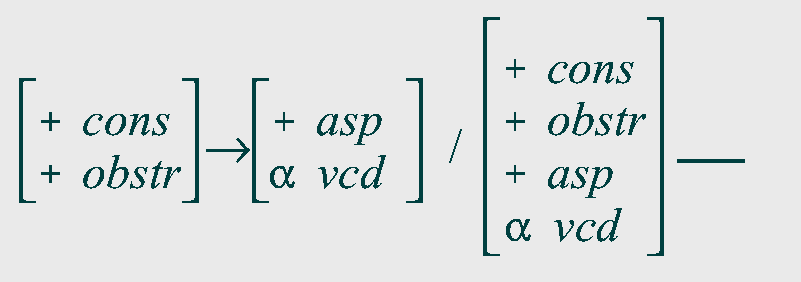 |
Notation with cover symbols:
| Δ → Φ / Φ _ →→ Φ → Bh / Bh _ |
Examples:
| PIE | Attested I.E. languages | ||||||||||||||
| phonolog. input | phonetic output | meaning / grammar | Ved. | Avest. | Greek | Arm. | Latin | OIr. / Cymr. | Goth. / OSax. | OHG | OCS | Lith. | Hitt. | Toch.A | Toch.B |
| bhudh-tˈos | bhutstós | ‘noticed, become aware’ (PPP) | (ἄ-)πυστος | ||||||||||||
| bhudzdhós | buddháḥ | ||||||||||||||
| uidh-tós | u̯itstós | ‘divided’ (PPP) | (dī-)vīsus | ||||||||||||
| u̯idzdhós | viddháḥ | ||||||||||||||
| iudh-tˈos | i̯utstós | ‘instigated (to fight)’ (PPP) | iussus | ||||||||||||
| i̯udzdhós | yuddháḥ | ||||||||||||||
| lubh-tˈeh2 | luptáh | ‘desired, beloved’ (PPP nom.sg.f.) | λυπτά | ||||||||||||
| lubdháh | lubdhā́ | ||||||||||||||
| uéǵh-tōr | u̯éḱtōr | ‘carrier’ (nom.sg.m.) | vectōr | ||||||||||||
| u̯éǵdhōr | voḍhā́, voḷhā́ | ||||||||||||||
| ueǵh-tˈos | u̯eḱtós | ‘carried, transported’ (PPP) | vašta- | vectus | fecht | ||||||||||
| u̯eǵdhós | |||||||||||||||
| uǵh-tˈos | uḱtós | ||||||||||||||
| uǵdhós | ūḍháḥ, ūḷháḥ | ||||||||||||||
4.1.5. Regressive aspiration by assimilation to following h2
(facultative rule in PIE?):
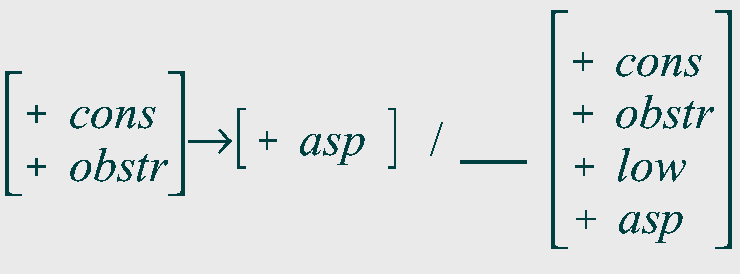 |
Notation with cover symbols:
| Δ → Φ /_ h2 |
Examples:
| PIE | Attested I.E. languages | ||||||||||||||
| phonolog. input | phonetic output | meaning / grammar | Ved. | Avest. | Greek | Arm. | Latin | OIr. / Cymr. | Goth. / OSax. | OHG | OCS | Lith. | Hitt. | Toch.A | Toch.B |
| sth2-tˈos | sthhəatós | ‘having stood’ (PPP) | sthitáḥ | status | -ssad | stãtas | |||||||||
| stəa(h)tós | στατός | ||||||||||||||
| sth2-tˈim | sthhəatím | ‘standing’ (acc.sg.f.) | sthítiṃ | statim | (staþ) | stat | |||||||||
| stəa(h)tím | στάσιν | ||||||||||||||
| pro-sth2-os | prosthhos | ‘standing forward’ (nom.sg.m.) | prasthaḥ | ross | prostŭ | ||||||||||
| mˈeǵh2 | meǵhhəa | ‘big’ (nom.sg.n.) | máhi | ||||||||||||
| meǵəa(h) | μέγα | mec | |||||||||||||
| meǵ | mek | ||||||||||||||
| mˈeǵh2-istos | méǵhhištos | ‘biggest’ (nom.sg.m.) | máhiṣṭhaḥ | mazištō | |||||||||||
| méǵ(h)istos | μέγιστος | ||||||||||||||
| plth2ˈus | pl̥thhuš | ‘broad’ (nom.sg.m.) | pṛthúḥ | pərəϑu- | leth | (platùs) | |||||||||
| pl̥t(h)us | πλατύς | ||||||||||||||
| plth2uˈih2 | pl̥thhəau̯íh | ‘earth’ (nom.sg.f.) | pṛthivī́ | pərəϑβī- | Cymr. Llydaw | ||||||||||
| pl̥təa(h)u̯íh | Πλαταια- | ||||||||||||||
| pl̥t(h)u̯íh | |||||||||||||||
| rˈot-h2-os | róthhos | ‘cart’ (nom.sg.m.) | ráthaḥ | raϑō | roth | rad | rãtas | ||||||||
| rót(h)os | |||||||||||||||
| rot-eh2 | rotah | ‘wheel’ (nom.sg.f.) | rota | ||||||||||||
| Problematic cases (implying loss of laryngeal): | |||||||||||||||
|---|---|---|---|---|---|---|---|---|---|---|---|---|---|---|---|
| dhugh2tˈēr | dhughhəatḗr | ‘daughter’ (nom.sg.f.) | duhitā́ | (kbatra) Lyc. | ckācar | tkācer | |||||||||
| dhugəa(h)tḗr | ϑυγάτηρ | ||||||||||||||
| dhugdhḗr | dugədā | ||||||||||||||
| dhuktḗr | dowstr | dauhtar | tochter | dŭštĭ | duktė̃ | ||||||||||
4.1.6. Assibilation of dental stops before dental stops:
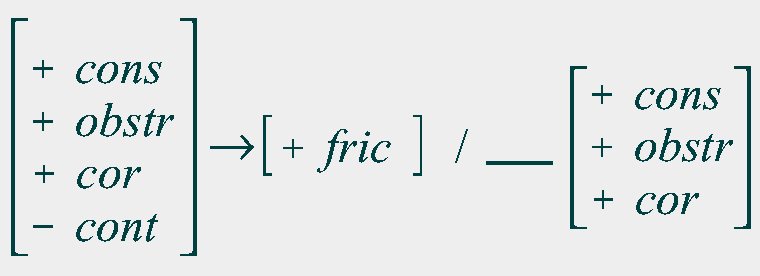 |
Notation with cover symbols:
| T → TS / _ T |
Examples:
| PIE | Attested I.E. languages | ||||||||||||||
| phonolog. input | phonetic output | meaning / grammar | Ved. | Avest. | Greek | Arm. | Latin | OIr. / Cymr. | Goth. / OSax. | OHG | OCS | Lith. | Hitt. | Toch.A | Toch.B |
| urt-tˈos | u̯r̥tstós | ‘turned’ (PPP) | vṛttáḥ | vorsus | fres- | vir̃stas | |||||||||
| bhudh-tˈos | bhutstós | ‘noticed, become aware’ (PPP) | (ἄ-)πυστος | ||||||||||||
| bhudzdhós | buddháḥ | ||||||||||||||
| iudh-tˈos | i̯utstós | ‘instigated (to fight)’ (PPP) | iussus | ||||||||||||
| i̯udzdhós | yuddháḥ | ||||||||||||||
| uidh-tós | u̯itstós | divided | (dī-)vīsus | ||||||||||||
| u̯idzdhós | viddháḥ | ||||||||||||||
| uid-tˈos | u̯itstós | ‘known’ (PPP) | vittáḥ | vistō | (ἄ-)Ϝιστος | uīsus | wis | (gi-)wis | |||||||
| h1ˈēd-ti | ՚ḗtsti | ‘eats’ (3.sg.prs.) | (átti) | (ἔδεται subj. > fut.) | *ēst | (ys) | (ist) | ěstŭ | ė́sti | ēšzi | |||||
| h1ed-dh·i | ՚eddhí | ‘eat!’ (2.sg.ipv.) | addhí | *ἐσϑί > ἐσϑίω | |||||||||||
| h1ed-tˈos | ՚etstós | ‘eaten’ (PPP) | ēsus | es | |||||||||||
| -sˈed-tis | -sétstis | ‘sitting’ (nom.sg.f.) | (ní-)ṣattiḥ | (ni-)šasti- | -sessiō | ||||||||||
| -sed-tˈos | -setstós | ‘sitten’ (PPP) | -sattáḥ | -sessus | |||||||||||
| uoid-th2e | u̯oi̯tsthha | ‘you have known’ (2.sg.pf.) | véttha | vōistā | (Ϝ)οῖσϑα | waist | uueist(u) | (věsi) | |||||||
| sḱhid-tós | sḱhitstós | ‘split’ (PPP) | (a-)sistō | σχιστός | scissus | ||||||||||
| Problematic cases (implying loss of laryngeals): | |||||||||||||||
|---|---|---|---|---|---|---|---|---|---|---|---|---|---|---|---|
| dhe-dhh1-tˈoi | dhedh՚ətói̯ | ‘puts for himself’ (3.sg.prs.med.) | (τίϑεται) | ||||||||||||
| dhetstói̯ | dhatté | ||||||||||||||
| dhedzdhói̯ | dazdē | ||||||||||||||
| de-dh3-tˈoi | dedՙətói̯ | ‘gives for himself’ (3.sg.prs.med.) | (διδοται) | ||||||||||||
| detstói̯ | datté | dastē | |||||||||||||
4.1.7. Dissimilation of dental stops before velar stops ("thorn" rule):
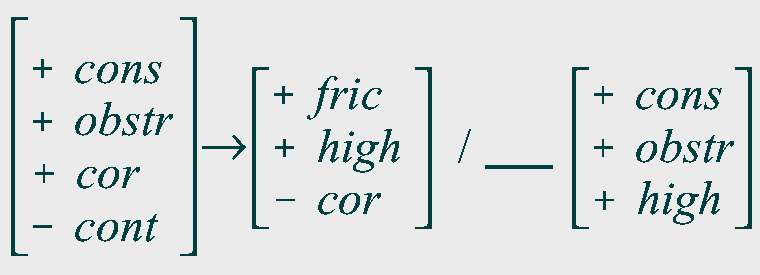 |
Notation with cover symbols:
| T → Þ / _ Ξ |
Examples:
| PIE | Attested I.E. languages | ||||||||||||||
| phonolog. input | phonetic output | meaning / grammar | Ved. | Avest. | Greek | Arm. | Latin | OIr. / Cymr. | Goth. / OSax. | OHG | OCS | Lith. | Hitt. | Toch.A | Toch.B |
| h2ˈrtḱos | hə́artśḱós | ‘bear’ | ursus | art | ḫartka- | ||||||||||
| hə́arḱtśós | ṛ́kṣaḥ | aršō | ἄρκτος | arǰ | |||||||||||
| tḱˈitis | tśḱítis | ‘settlement’ (nom.sg.f.) | |||||||||||||
| ḱtśítiš | kṣitíḥ | šiti- | |||||||||||||
| ḱtśítis | κτίσις | ||||||||||||||
| dhǵhuH-m | dźǵhúhm | ‘fish’ (acc.sg.m.) | |||||||||||||
| dźǵhúhm̥ | |||||||||||||||
| ǵdźhúhm | ἰχϑὺν | ||||||||||||||
| ǵdźhúhm̥ | jukn | žùvį́ | |||||||||||||
| dhǵhˈom-i-os | dźǵhómii̯os | ‘earthly’ (nom.sg.m.) | |||||||||||||
| ǵdźhómii̯os | kṣámiyaḥ | χϑόνιος | duine | ||||||||||||
| dhǵhem-iˈeh2 | dźǵhemi̯áh | ‘land’ (nom.sg.f.) | |||||||||||||
| ǵdźhemi̯ah | zemljá | žẽmė | |||||||||||||
| dhǵhm-ˈes | dźǵhmés | ‘earth’ (gen.sg.f.) | dagnaš | ||||||||||||
| ǵdźhmés | kṣmáḥ | zəmō | |||||||||||||
| dźhmés | jmáḥ | ||||||||||||||
| dźhm̥mes | |||||||||||||||
| dhǵhm-ˈei | dźǵhmei̯ | ‘earth’ (dat.sg.f.) | |||||||||||||
| ǵdźhmei̯ | (kṣmé) | zəmē | |||||||||||||
| dźhmei̯ | jmé | ||||||||||||||
| dźhm̥mei̯ | (χαμαί) | ||||||||||||||
| dhˈeǵhōm | dhéǵhōm | ‘earth’ (nom.sg.f.) | dēgan | ||||||||||||
| > dhǵhˈōm | dźǵhṓm | (zå̄) | |||||||||||||
| ǵdźhṓm | (kṣāḥ) | χϑών | |||||||||||||
| dh’eǵhom-m | dhéǵhomm̥ | ‘earth’ (acc.sg.f.) | |||||||||||||
| dhéǵhōm | |||||||||||||||
| > dhǵhˈom-m | dźǵhomm̥ | tkaṃ | keṃ | ||||||||||||
| ǵdźhomm̥ | χϑόνα | ||||||||||||||
| dźǵhōm | ząm | ||||||||||||||
| ǵdźhōm | kṣā́m | ||||||||||||||
| ˈn-dhgwhi-tom | ń̥dźgwhitóm | ‘imperishable’ (neg. PPP, nom.sg.n.) | |||||||||||||
| ń̥gwdźhitóm | ákṣitam | ἄϕϑιτον | |||||||||||||
| dhgwhˈi-tis | dźgwhítis | ‘peril’ (nom.sg.f.) | |||||||||||||
| gwdźhítis | |||||||||||||||
| gwdźhítiš | kṣitíḥ | ϕϑίσις | |||||||||||||
| dhgwhineHti | dźgwhinEHti | ‘destroys’ (3.sg.prs.) | jināiti | ||||||||||||
| gwdźhinEHti | kṣiṇāti | (ϕϑίνει) | |||||||||||||
4.1.8. "Ruki" rule (facultative rule in PIE?):
4.1.8.1. a) after i,u:
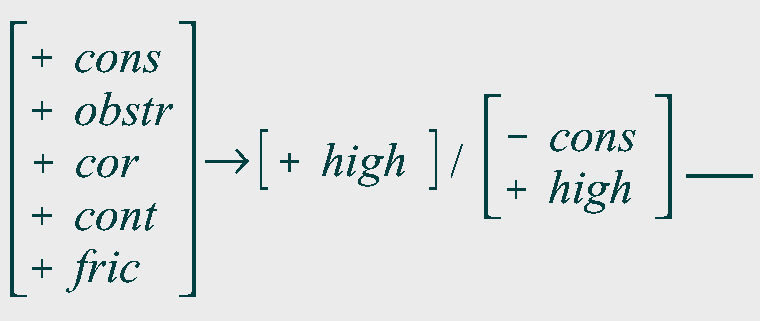 |
Notation with cover symbols:
| s → š / I _ |
Examples:
| PIE | Attested I.E. languages | ||||||||||||||
| phonolog. input | phonetic output | meaning / grammar | Ved. | Avest. | Greek | Arm. | Latin | OIr. / Cymr. | Goth. / OSax. | OHG | OCS | Lith. | Hitt. | Toch.A | Toch.B |
| duís | du̯ís | ‘twice’ | δίς | duis > bis | twis | zwir- | |||||||||
| duu̯ís | |||||||||||||||
| du̯íš | dvíḥ | ϑβiš | |||||||||||||
| duu̯íš | duvíḥ | ||||||||||||||
| trís | trís | ‘thrice’ | τρίς | ter | |||||||||||
| tríš | tríḥ | ϑriš | |||||||||||||
| h1ish1/2rˈos | ՚isəe/a(՚/h)rós | ‘vivid; holy’ | ἱε/αρός | (IARI) | (isara) | ||||||||||
| ՚išəe/a(՚/h)rós | iṣiráḥ | ||||||||||||||
| toisu | toi̯su | ‘in these’ (loc.pl.) | τοῖσι | ||||||||||||
| toi̯šu | téṣu | *taēšu | těxŭ | ||||||||||||
| h2usih1 | husi՚ | ‘ears’ (nom.du.n.) | |||||||||||||
| huši՚ | ušī | uši | |||||||||||||
| h2ˈeusos | háusos | ‘ear’ (nom.sg.n.) | (auris) | áu | (ausō) | (ōra) | (ausìs) | ||||||||
| háušos | uxo | ||||||||||||||
| h2ˈeusōs | háusōs | ‘dawn’ (nom.sg.f.) | ἠώς | (aurōrā) | |||||||||||
| háušōs | (uṣ.ā́ḥ) | ||||||||||||||
| > h2usˈōs | husṓs | ||||||||||||||
| hušṓs | (uṣā́ḥ) | (ušå̄) | |||||||||||||
| h2ˈeusom | háusom | ‘gold’ (nom.sg.n.) | aurum | ausas > áuksas | (wäs) | (yasa) | |||||||||
| háušom | |||||||||||||||
| h1ˈeus-eti | ՚éu̯seti | ‘burns’ (3.sg.prs.) | εὕει | ūrit | |||||||||||
| ՚éu̯šeti | oṣati | ||||||||||||||
| h1ustˈos | ՚ustós | ‘burned’ (PPP, nom.sg.m.) | ustus | ||||||||||||
| ՚uštós | uṣṭáḥ | ||||||||||||||
| dus-h1ˈeusom | dus՚éusom | ‘hard to burn’ (acc.sg.m.) | |||||||||||||
| duš՚éušom | duróṣam | dūraošəm | |||||||||||||
| dus-menˈeses | dusmenéses | ‘badly minded’ (nom.pl.m.) | δυσμενέα | ||||||||||||
| dušmenéses | durmanasaḥ | dušmanaŋhō | |||||||||||||
| (s)nusˈos | (s)nusós | ‘daughter-in-law’ (nom.sg.f.) | νυός | now | nurus | ||||||||||
| (s)nušós | |||||||||||||||
| (s)nusˈeh2 | (s)nusáh | ||||||||||||||
| (s)nušáh | snuṣā́ | snor | snur | snŭxá | |||||||||||
4.1.8.2. b) after velars:
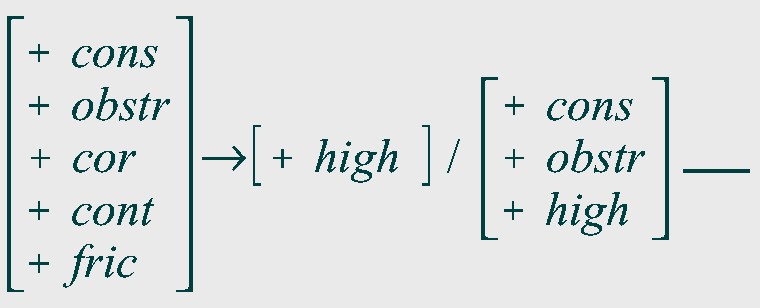 |
Notation with cover symbols:
| s → š / Ξ _ |
Examples:
| PIE | Attested I.E. languages | ||||||||||||||
| phonolog. input | phonetic output | meaning / grammar | Ved. | Avest. | Greek | Arm. | Latin | OIr. / Cymr. | Goth. / OSax. | OHG | OCS | Lith. | Hitt. | Toch.A | Toch.B |
| ksurˈos | ksurós | ‘knife’ (nom.sg.m.) | ξυρός | ||||||||||||
| kšurós | kṣuráḥ | ||||||||||||||
| uksˈōn | uksṓn | ‘ox’ (nom.sg.m.) | ych | *aúhsa | ohso | okso | |||||||||
| ukšṓn | ukṣā́ | uxšā | |||||||||||||
| uksˈenm | uksénm̥ | ‘ox’ (acc.sg.m.) | |||||||||||||
| ukšénm̥ | ukṣánam | ||||||||||||||
| uksˈonm | uksónm̥ | ||||||||||||||
| ukšónm̥ | ukṣā́nam | uxšānəm | |||||||||||||
| -rˈēǵs | -rḗḱs | ‘ruler’ (in comp., nom.sg.m.) | rēx | rī | |||||||||||
| -rḗḱš | -rā́ṭ | ||||||||||||||
| -uēǵh-s-t | -u̯ēḱst | ‘carried’ (3.sg.aor.) | (vēxit) | (věs-) | |||||||||||
| -u̯ēḱšt | (á)-vāṭ | ||||||||||||||
| uˈeǵh-s-e-t(i) | u̯éḱset(i) | ‘will carry’ (3.sg.aor.subj.) | |||||||||||||
| u̯éḱšet(i) | |||||||||||||||
| u̯éǵžhet(i) | vákṣat(i) | (uz-)uuažat | |||||||||||||
| h2uogs-eie-ti | hu̯oksei̯eti | ‘grows’ (3.sg.prs.caus.) | wahseiþ | ||||||||||||
| hu̯okšei̯eti | vakṣaya(m) | vaxšaiiat(ō) | |||||||||||||
| uˈōkw-s | u̯ṓkws | ‘voice’ (nom.sg.f.) | vōx | ||||||||||||
| u̯ṓkwš | vā́k | vāxš | |||||||||||||
Unification of rules a) and b):
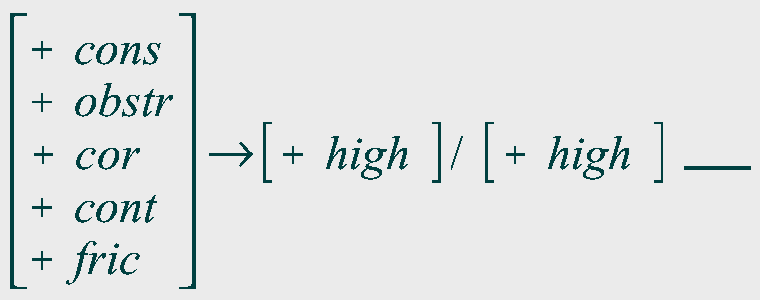 |
Notation with cover symbols:
| s → š / I | Ξ _ |
4.1.8.3. b) after r:
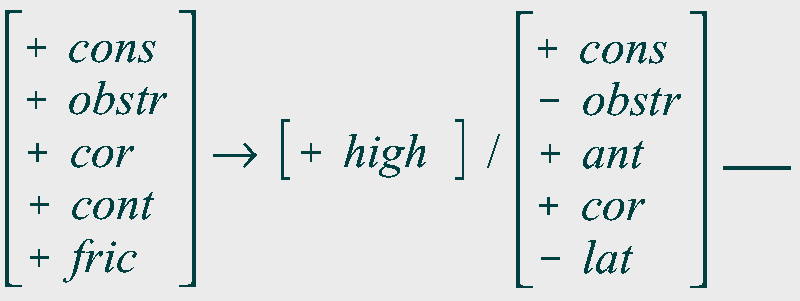 |
Notation with cover symbols:
| s → š / r _ |
Examples:
| PIE | Attested I.E. languages | ||||||||||||||
| phonolog. input | phonetic output | meaning / grammar | Ved. | Avest. | Greek | Arm. | Latin | OIr. / Cymr. | Goth. / OSax. | OHG | OCS | Lith. | Hitt. | Toch.A | Toch.B |
| h2rsēn | hr̥sēn | ‘male (bull)’ (nom.sg.m.) | ἄρσ/ρην | (orre-) | |||||||||||
| hr̥šēn | (ṛṣa-) | arša | |||||||||||||
| tˈrsus | tŕ̥sus | ‘dry’ (nom.sg.m.) | þaúrsus | (durri) | |||||||||||
| tŕ̥šus | tṛṣúḥ | taršu- | |||||||||||||
| trstˈos | tr̥stós | ‘thirsty’ (nom.sg.m.) | tart | (þaurstei) | (durst) | ||||||||||
| tr̥štós | tṛṣṭáḥ | tarštō | |||||||||||||
| Hˈorsos | Hórsos | ‘ass, buttock’ (nom.sg.m.) | ὄρρος | or̄ | ars | ars | arra- | ||||||||
| Hóršos | |||||||||||||||
| prsth2ˈom | pr̥sth(h)óm | ‘peak, ridge’ (acc.sg.m.n.) | prĭstŭ | pir̃stą | |||||||||||
| pr̥šth(h)óm | pṛṣṭhám | parštəm | |||||||||||||
| meh2tˈr-s | mahtŕ̥s | ‘mother’ (gen.sg.f.) | |||||||||||||
| mahtŕ̥š | mātúr | *mātərəš | |||||||||||||
| meh2tr-ˈes | mahtrés | mātris | matere | móteres | (mātri) | ||||||||||
| meh2tr-ˈos | mahtrós | μητρός | mawr | máthar | muoter | ||||||||||
4.2. Rules of syllabification
4.2.1. Hierarchy:
| Rank | Sound category | Conditions of syllabicity |
| I. | Non-high vowels | Always (wherever they appear) |
| II. | High vowels, nasals, liquids | When not adjacent to sound of category I and when not followed by syllabic sound of category II ("Schindler's rule"); |
| when, as second element of syllable, followed by sound of category I in word-final syllable ("Sievers'" and "Lindeman's" laws) | ||
| III. | Laryngeals | When not adjacent to sound of category I or syllabic sound of category II |
| IV. | "Shewa secundum" | Within remaining clusters of non-syllabic consonants (facultatively) |
4.2.2. Schematic rule representation:
4.2.2.1. Non-high vowels ("syllabic" not regarded as an underlying feature)
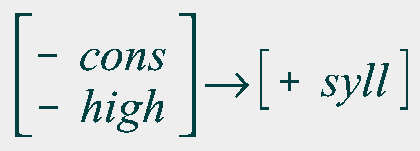 |
4.2.2.2. Other sonorants ("sonorant" not regarded as an underlying feature):
Schindler's rule ( Die Sprache 23 [1977], p. 56):
 |
Notation with cover symbols ("colouring" not accountable for):
| R → R̥ / (# | C) _ (C | #) |
(rule operating iteratively from right to left, with high vowels, nasals and
liquids regarded as being underlyingly non-syllabic)
4.2.2.2.1. Subrule I: Sievers' law (after
Schindler, o.c., p. 57):
 |
Alternative notation with cover symbols:
| R → R̥ / WCn1 _ VCn0# | VRCn1 _ VCn0# |
Same with notation of presumptive syllable boundaries (.):
| R → R̥ / W.Cn1 _ VCn0# | VR.Cn1 _ VCn0# |
N.B. Tautosyllabic obstruent clusters are no valid condition:
| R → R / VPP. _ VCn0# |
4.2.2.2.2. Lindeman's law:
 |
Notation by cover symbols:
| R → R̥ / #Cn1 _ VCn0# |
Example:
| Paradigm *{ḱuon-} "dog" | ||||||
| Case form | phonological input | phonetic output | Old Indic | Greek | ||
| attested | expected | |||||
| Nom.Sg. | /ḱuō(n)/ | → | [ḱu̯ō(n)] / [ḱuu̯ō(n)] | śuvā | κύων / †πῶν | |
| Acc.Sg. | /ḱuón-m/ | → | [ḱu̯ónm̥] | śvā́nam | <κύνα> | †πόνα |
| Gen.Sg. | /ḱun-és/ | → | [ḱunés] | śunás | (κυνός) | †κυνές |
| Nom.Pl. | /ḱuón-es/ | → | [ḱu̯ónes] | śvā́nas | <κύνες> | †πόνες |
| Acc.Pl. | /ḱun-ns/ | → | [ḱunn̥s] | śunás | κύνας | |
| Instr.Pl. | /ḱun-bʰís/ | → | [ḱu̯n̥bʰís] | śvabhís | ||
| Loc.Pl. | /ḱun-sú/ | → | [ḱu̯n̥sú] | *śvasú | <(κῡσί)> | †πασύ |
4.2.2.3. Laryngeals (N.B.: syllabicity of obstruents phonetically implausible)
 |
Notation with cover symbols ("colouring" not accountable for):
| H → H̥ / (C | #) H _ (C | #) |
4.2.2.3.1. Alternative solutions:
4.2.2.3.1.1. Shewa anaptyxis before laryngeals:
 |
Notation with cover symbols ("colouring" not accountable for):
| Ø → ə / (C | #) _ H (C | #) |
4.2.2.3.1.2. Shewa anaptyxis after laryngeals:
 |
Notation with cover symbols ("colouring" not accountable for):
| Ø → ə / (C | #) H _ (C | #) |
4.2.2.3.1.3. Shewa substitution (N.B.: "double" effects not accountable for):
 |
Notation with cover symbols ("colouring" not accountable for):
| H → ∀ / (C | #) _ (C | #) |
4.2.3. Other rules concerning laryngeals:
4.2.3.1. "Colouring":
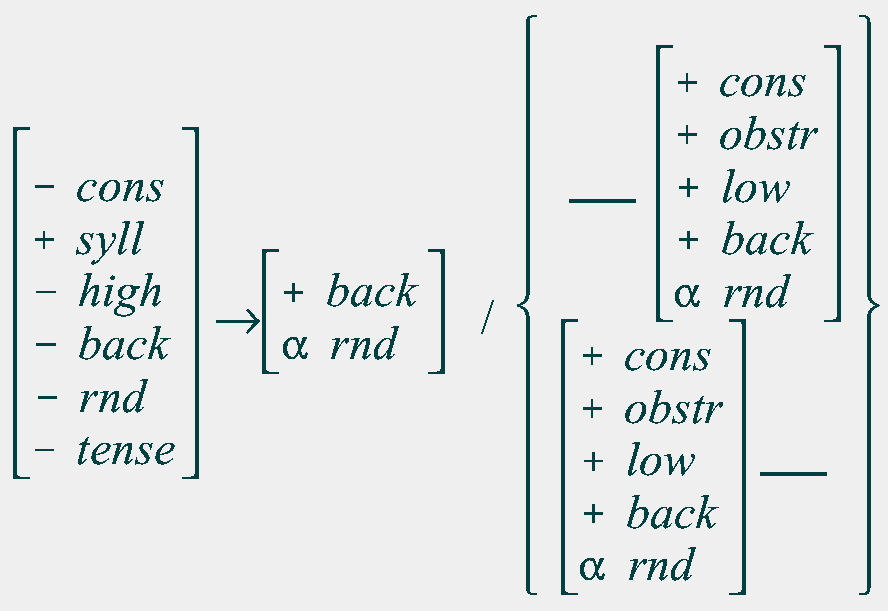 |
Notation with cover symbols:
| e → a / ( _ h2 ) | ( h2 _ ) |
| e → o / ( _ h3 ) | ( h3 _ ) |
4.2.3.2. Loss of laryngeal in pausa position ("Kuiper's
law", facultative; after colouring!):
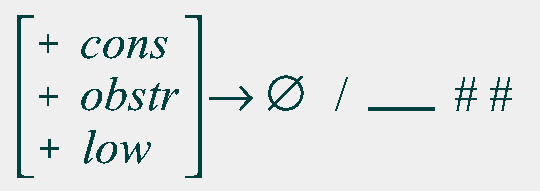 |
Notation with cover symbols:
| H → Ø / _ ## |
4.2.3.3. "Compensatory lengthening":
4.2.3.3.1. a) coinciding with colouring:
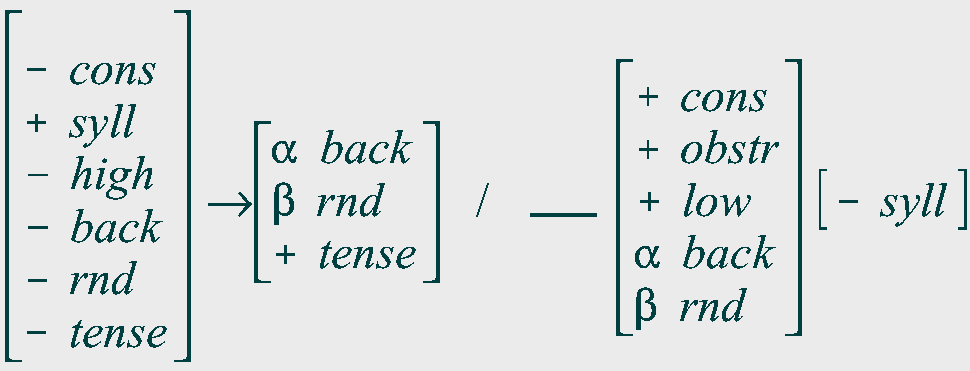 |
| e → ē / _ h1C |
| e → ā / _ h2C |
| e → o / _ h3C |
4.2.3.3.2. b) same, with laryngeals "absorbed":
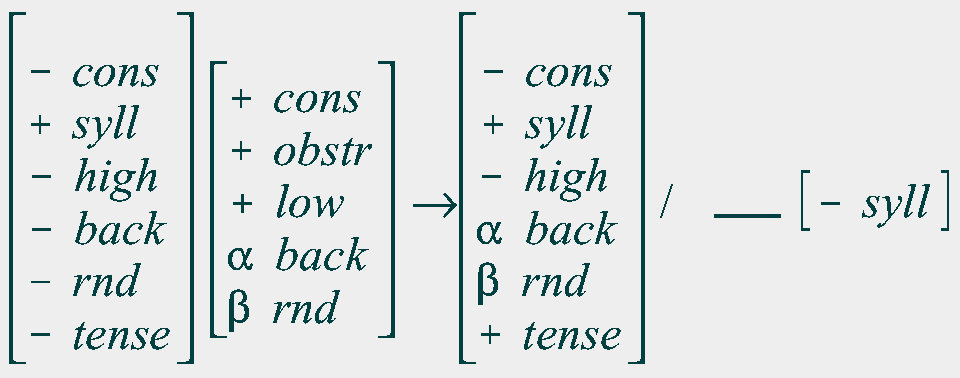 |
| eh1 → ē / _ C |
| eh2 → ā / _ C |
| eh3 → o / _ C |
N.B. This cannot be the general rule of PIE because *h2
has been preserved as ḫ in this position in Anatolian; cp., e.g. Hitt.
paḫš- < *peh2-sḱ- vs. Lat.
pāscō etc.
4.2.3.3.3. c) rule to be applied after colouring, including lengthening of
i,u,r̥,l̥,m̥,n̥:
 |
| V → V̄ / _ HC |
N.B. In the case of nasals and liquids, this rule can hardly represent the
actual phonetic development if we consider the Greek development of -ενε- vs
-νη- etc. (governed by accent? ablaut levelling?); rather a rule of shewa
anaptyxis? Cp.
| PIE | Greek | Latin | Slavic | Indo-Iranian | Toch.B | |||
| phonological input | phonetic output | Proto-Greek | Classic | OInd. | Avest. | |||
| /ǵˈn̥h1-ti-s/ ← {ǵˈenh1-ti-s}? |
[ǵə́en՚əetis] | *génetis | γένεσις | |||||
| [ǵnəe՚tis] | nāti-ō | |||||||
| /ǵn̥h1-tˈo-s/ | [ǵnəe՚tós] | *gnātós | (κασί-)γνητος | nātus | ||||
| [ǵəen՚tós] | jātáḥ | jātō | ||||||
| /ḱˈr̥h2sˈn-h2/ ← {ḱˈerh2sn-h2}? |
[ḱəar̥̄hsn̥̄́h] | śīrṣā́ | ||||||
| [ḱə́arhəasnəah] | *kárahna | κάρηνα | ||||||
| /ḱr̥h2sn̥-ˈes/ | [ḱəarhsnés] | śīrṣṇás | ||||||
| /ḱˈr̥h2sn̥-tos/ | [ḱrə́ahsn̥tos] | *krā́hatos | κρᾱ́ατος | |||||
| /ḱˈr̥h2os/ | [ḱə́arhos] | śíraḥ | sarə̄ | |||||
| /-str̥h3-toi/ | [-stəorՙə3toi] | *-storotoi̯ | ἐ-στόροται | |||||
| /str̥h3-tˈo-s/ | [strəoՙtós] | *strōtós | στρωτός | strātus | ||||
| [stəorՙtós] | (stīrṇáḥ) | starətas- | ||||||
| /pˈrh3uos/ | [pə3rՙu̯os] | pĭ́rvŭ-jŭ | pū́rvaḥ | pouruuō | pärwe-ṣṣe | |||
| /pˈrh3tos/ | [prə́3ՙtos] | *prṓtos | πρῶτος | |||||
4.2.3.3.4. d) same in word final position: three (facultative) effects:
4.2.3.3.4.1. lengthening:
 |
| V → V̄ / _ HC |
4.2.3.3.4.2. loss of laryngeal ("Kuiper's law"):
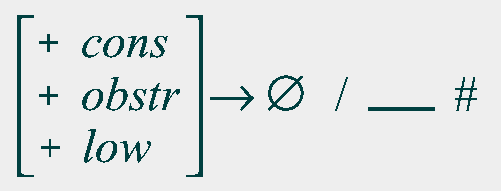 |
Notation with cover symbols:
| H → Ø / V _ # |
4.2.3.3.4.3. after i,u: shewa anaptyxis before laryngeal:
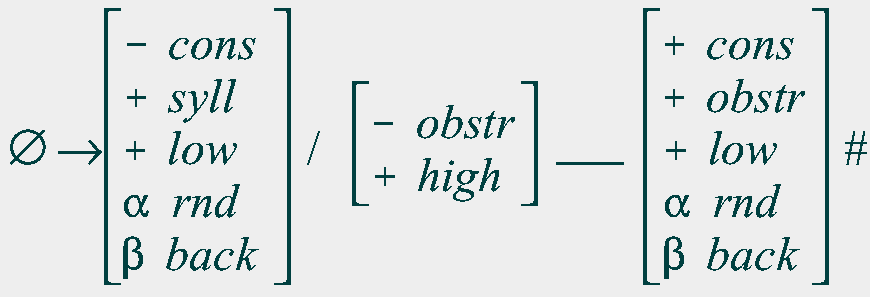 |
Notation with cover symbols ("colouring" not accountable for):
| Ø → ə / R _ H # |
Examples:
| phonological input | phonetic output | Attested I.E. languages | ||
| */pˈih1uerih2/ | → | [pī́u̯erī] | > | OInd. pī́varī |
| → | [pī́u̯eri] | > | OInd. voc. *pī́vari | |
| → | [pī́u̯eri̯əah] | > | Greek πίειρα | |
| /pˈotnih2/ |
→ | [pótnī] | > | OInd. pátnī |
| → | [pótni] | > | OInd. voc. pátni | |
| → | [pótnii̯əah] | > | Greek πότνια | |
| /plth2uˈih2/ |
→ | [pl̥thhəau̯ī́] | > | OInd. pr̥th(i)vī́ |
| → | [pĺ̥thhəau̯i] | > | OInd. voc. pŕ̥th(i)vi | |
| → | [pl̥təahu̯i̯əah] | > | Greek *πλαταῖα | |
| /h3kwih1 | → | [ՙəokwī] | > | (Arm. ačՙ-kՙ, Slav. očī, Lith. akì) |
| → | [ՙəokwi] | |||
| [ՙəokwi̯əe՚] | > | Greek ὄσσε |
4.2.3.4. Occlusives ("shewa secundum"). Cf. Peters,
Laryngale, 98. N.B.: This "shewa" to be regarded as unrounded high vowel
Notation with cover symbols:
| Ø → i̵ / #Z_ZC |
N.B. This rule is facultative; it alternates with cluster reduction:
Notation with cover symbols:
| Z → Ø / #_ZC |
N.B. This rule must be applied before Lindeman's law.
4.3. Further rules concerning syllabification:
4.3.1. Stang's (second) law:
Notation with cover symbols:
| EI → Ē / _ N |
Examples:
| phonological input | phonetic output | Attested I.E. languages | ||
| */dieum/ | → | [d(i)i̯ēm] | > | OInd. diyām, Greek ζῆν, Lat. *diēm > diem |
| */gwoum/ | → | [gwōm] | > | OInd. gām, Greek βῶν |
4.3.2. Stang's law applied to
laryngeals:
This rule is obviously facultative, alternating with syllabification of the
nasal involved:
Examples:
| phonological input | phonetic output | Attested I.E. languages | ||
| */teh2m/ | → | [tām] | > | OInd. tām, Greek τήν, OCS tǫ |
| */teh2ns/
|
→ | [tāns] | > | Greek τᾱ́ς < τανς << τᾱνς; |
| → | [tahn̥s] | > | PIIr. *tahas > OInd. tās; | |
| */h2uˈeh1ntos/
|
→ | [hu̯ḗntos] | → | Toch. want / yente; Goth. winds, Lat. uentus |
| → | [hu̯é՚n̥tos] | → | OInd. Avest. <vā́tas> [u̯aatas] |
4.3.3. Rix' law (concerning Greek):
4.3.3.1. Alternative interpretation 1: Shewa substitution:
4.3.3.2. Alternative interpretation 2: Left shewa anaptyxis:
N.B. Must be applied before Osthoff's law?
4.3.3.3. Alternative interpretation 3: Right shewa anaptyxis:
Examples:
| phonological input | phonetic output | Attested I.E. languages | ||
| *h1rsḱˈe- | → | [՚r̥sḱé-] | > | OInd. r̥cchá-ti |
| → | [՚əersḱé-] | > | Greek ἔρχε-ται | |
| *h2mbhˈi) | → | [hm̥bhí] | > | OInd. abhí, OHG umbe |
| → | [həambhí] | > | Greek ἄμϕί | |
| *h3nbhl- | → | [ՙn̥bhl-] | > | Lat. umbilīcus, OIr. imbliu |
| → | [ՙəonbhl̥l-] | > | Greek ὄμϕαλός | |
| *h3nobh- | → | [ՙəonobh] | > | OHG nabulo, OInd. nābha- |
| *h3nebh- | → | [ՙəonebh] | > | Arm. aniw |
5. Rules concerning individual branches or languages
5.1. General tendencies in the development of the system of stops:
| Proto-IE. | T | M | MA | Rules to be observed |
| Old-Indic | T | M | MA | , |
| Old-Iranian | T | M | , | |
| Greek | T | M | TA | |
| Italic | T | M | TA > F | |
| Celtic | T | M | ||
| Germanic | F | T | M > F | |
| Balto-Slavic | T | M | ||
| Armenian | TA | TG | M | |
| Tocharian | T | |||
| Anatolian | T? | M? | ||
5.1.1. Glottalistic reinterpretation:
| Proto-IE. | TA | TG | MA | Rules to be observed |
| Old-Indic | T | M | MA | , |
| Old-Iranian | T | M | , | |
| Greek | T | M | TA | |
| Italic | T | M | TA > F | |
| Celtic | T | M | ||
| Germanic | F | T | M > F | |
| Balto-Slavic | T | M | ||
| Armenian | TA | TG | M | |
| Tocharian | T | |||
| Anatolian | T? | M? | ||
N.B.: T = Tenuis, M = Media, MA = Media Aspirata, TA = Tenuis Aspirata,
F = Fricative, TG = Tenuis Glottalis
5.1.2. Special rules for original mediae aspiratae in Latin:
5.1.2.1. Proto-Italic development:
5.1.2.1.1. Desonorization (as in Greek):
| ↓ | *bʰ | *dʰ | *ǵʰ/*gʰ | *gwʰ |
| *pʰ | *tʰ | *kʰ | *kwʰ |
5.1.2.1.2. Fricativization (as in later Greek):
| ↓ | *pʰ | *tʰ | *kʰ | *kwʰ |
| *f | *ϑ | *χ | *χw |
5.1.2.2. Proto-Latin developments:
5.1.2.2.1. Sonorization in intervocalic position:
| ↓ | *f | *ϑ | *χ | *χw |
| *ƀ | *ð | *ǥ | *ǥw |
5.1.2.2.2. Further development of dental fricatives:
5.2. Grimm's / Verner's law
5.2.1. Rule A:
5.2.2. Rule B:
5.2.3. Rule C:
5.2.4. Rules B and C unified:
5.3. Grassmann's law (dissimilation of aspirated sounds, valid independently for Indo-Iranian and Greek)
 |
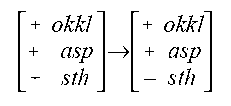 |
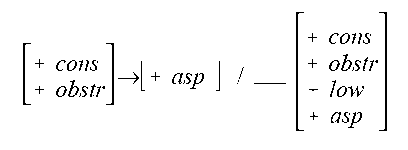 |
| PIE | PIIr. | OInd. | Avest. | |||
| phonological input | phonetic output | Early | Late | phonologically | graphically | |
| –kwe | [–kwe] | *–če | *–ča | –ca | /-ca/ | <-ca> |
| gwˈenh2 | [gwénəah] | *ǰénə | *ǰánə | jáni- | /jani-/ | |
| gwʰˈen-ti | [gwʰénti] | *ǰʰénti | *ǰʰánti | hánti | /janti/ | |
| kiˈeue–toi | [ki̯éu̯etoi̯] | *či̯éu̯etoi̯ | *či̯áu̯atai̯ | cyávate | /ši̯au̯a-/ | <š́(ii)auua–> |
| iungˈenti | [i̯ungénti] | *i̯unǰénti | *i̯unǰénti | yuñjánti | */i̯unjanti/ | * |
| gʰˈedeti | [gʰédeti] | *ǰʰédeti | *ǰʰádati | *hadati | ||
5.8. The Slavic palatalizations
5.8.1. First palatalization
N.B. The rule must be applied before the monophthongization of *oi̯, *ai̯
> ě (cf. below), but after the effects of the ruki-rule (cf. )
leading from *s > x:
5.8.2. Second palatalization
5.8.2.1. East- and South-Slavic:
5.8.2.2. West-Slavic:
N.B.: The conditioning vowel must be the result of a or o plus
i (diphthong, later merging with ě or ī).
5.8.3. Third palatalization:
5.8.3.1. East- and South-Slavic:
5.8.3.2. West-Slavic:
| Achtung: Dieser Text ist mit Unicode / UTF8 kodiert. Um die in ihm erscheinenden Sonderzeichen auf Bildschirm und Drucker sichtbar zu machen, muß ein Font installiert sein, der Unicode abdeckt wie z.B. der TITUS-Font Titus Cyberbit Unicode. | Attention: This text is encoded using Unicode / UTF8. The special characters as contained in it can only be displayed and printed by installing a font that covers Unicode such as the TITUS font Titus Cyberbit Unicode. |
Copyright Jost Gippert Frankfurt a/M
2001. No parts of this document may be republished in any form without prior
permission by the copyright holder.